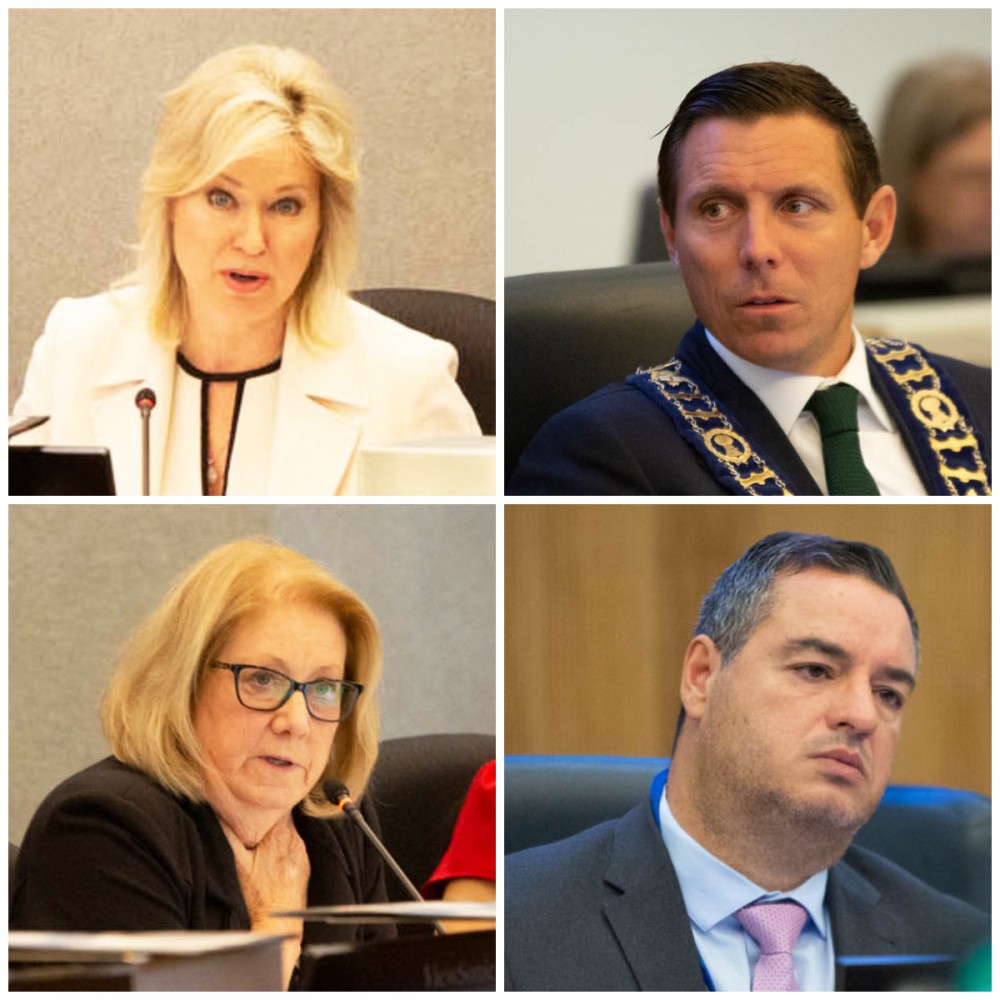
Policing at the centre of regional feud as Brampton members walk out of meeting
Peel Regional Police was front and centre during a tumultuous day at the Region of Peel. In a crammed schedule councillors considered broad regional budget cuts, the police budget and the model for the force’s funding, before every councillor from the City of Brampton walked out of regional council, forcing a shut down.
The regional clerk described the adjournment due to a lack of quorum as “not unprecedented, but rare”, after councillors waited 30 minutes for their Brampton colleagues to return to vote. At least one regional council member from each of Peel’s three local municipalities has to be present during a meeting for it to continue.
Councillors from Brampton left the Council Chamber during a vote on the funding model applied to Peel Police. The motion on the floor at the time was backed by Mississauga and looked to shift as much as $69 million in annual police costs to Brampton in a model Mayor Bonnie Crombie said was more “equitable”.
Mississauga has argued that the funding model should be based on the number of police calls and work that takes place in each city, otherwise its taxpayers end up subsidizing policing in Brampton, where, according to data being used by Mississauga, most policing activity takes place.
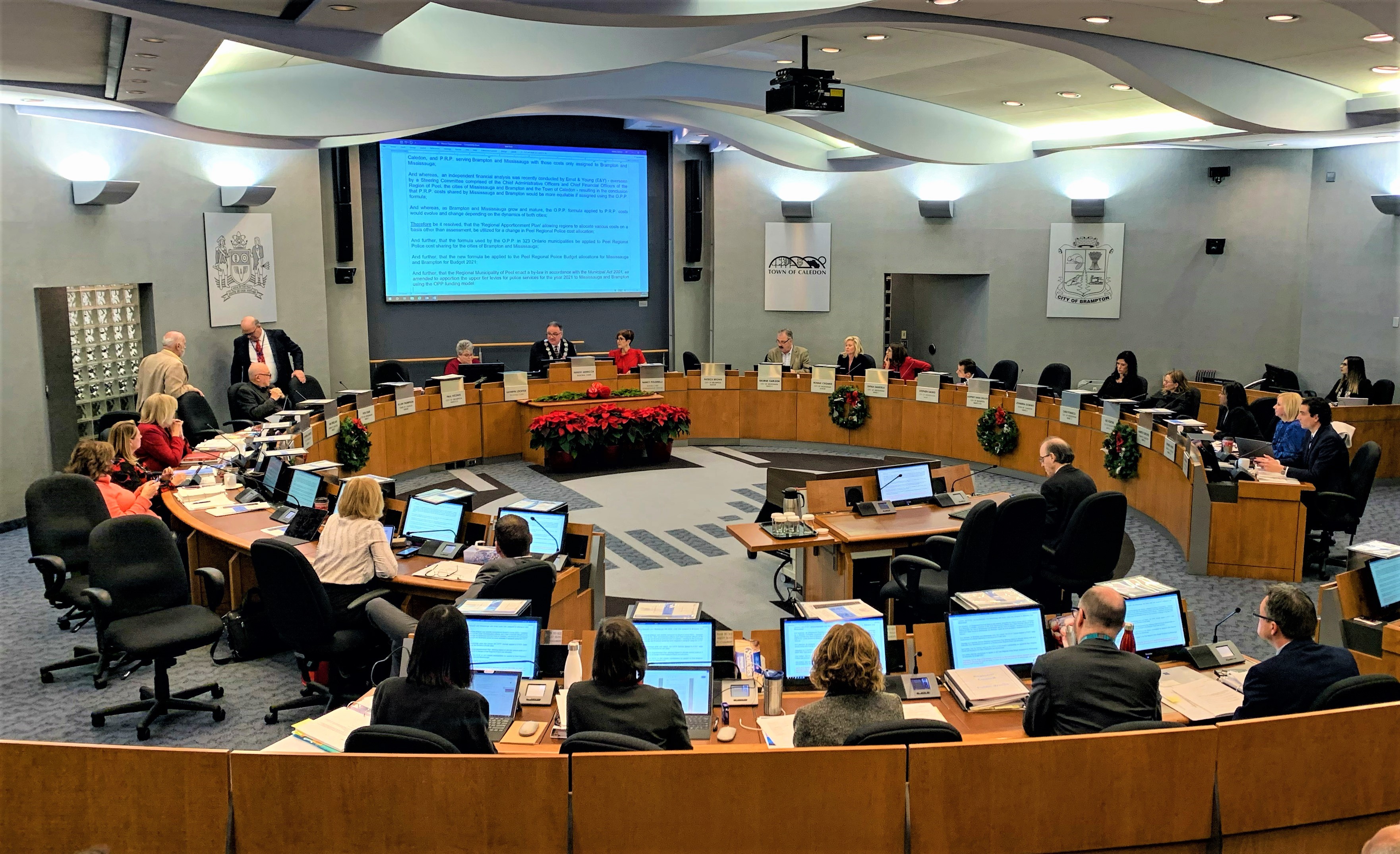
Mississauga and Caledon Regional Councillors wait Thursday to see if the Peel Council meeting will continue after Brampton members walked out in protest
Speaking to The Pointer after the council meeting, Brampton Mayor Patrick Brown accused Mississauga of raising the issue of police funding in protest against the result of the provincial government’s recent review of regional government which left the Region of Peel intact, causing frustration among Mississauga members who aggressively lobbied for their city’s independence.
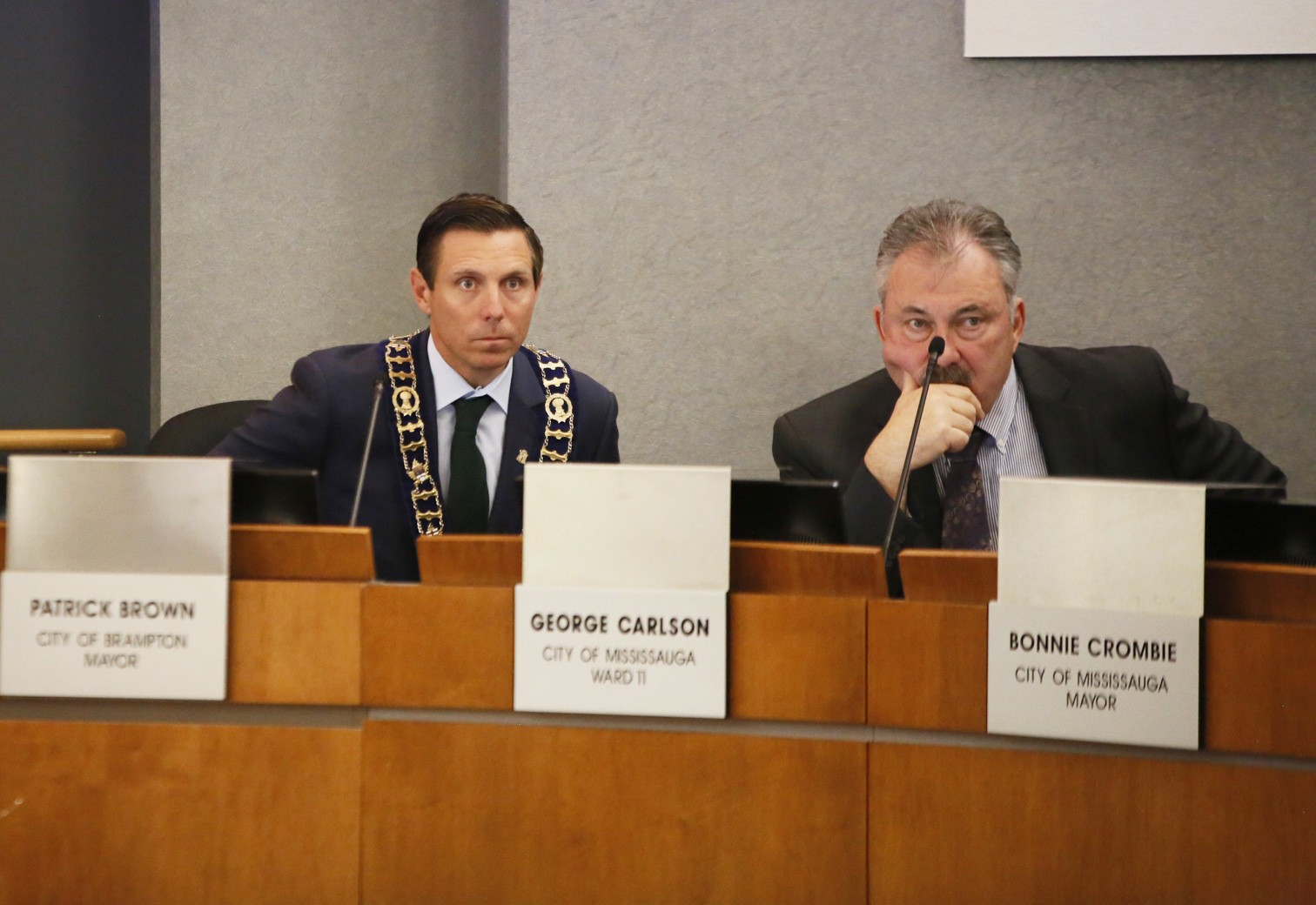
Brampton Mayor Patrick Brown (left)
“We won’t let Mississauga destabilize the region because they didn't get the result they wanted,” Brown said, accusing the city of pulling a “stunt” with the police funding model motion.
Even before the walkout, tensions were high.
During a morning budget committee meeting, Mississauga and Brampton clashed on the issue of the police budget. Brown, a police booster, advocated for the large police funding increase being requested by PRP (even though he demands low or no budget increases in almost every other area), defended the force’s request for a 5.4 percent increase which includes plans for an additional 35 officers. The request marks an almost 70 percent police budget increase over ten years, prompting other members to question if throwing money at crime is working. They suggested smarter use of the existing budget.
Mississauga, led by Carolyn Parrish, Mayor Crombie and Pat Saito, argued for a reduction in the budget citing the fact that other arms length agencies, such as the conservation authorities, had managed to reduce their demands when asked.
As Brown alluded to in his comments, the disagreements on policing between Brampton and Mississauga felt like a hangover from the Regional Review. Representing the largest city in the region and the third largest in the province and sixth largest in the country, councillors from Mississauga have made clear that they believe the city’s taxpayers are paying far more than their fair share in Peel.
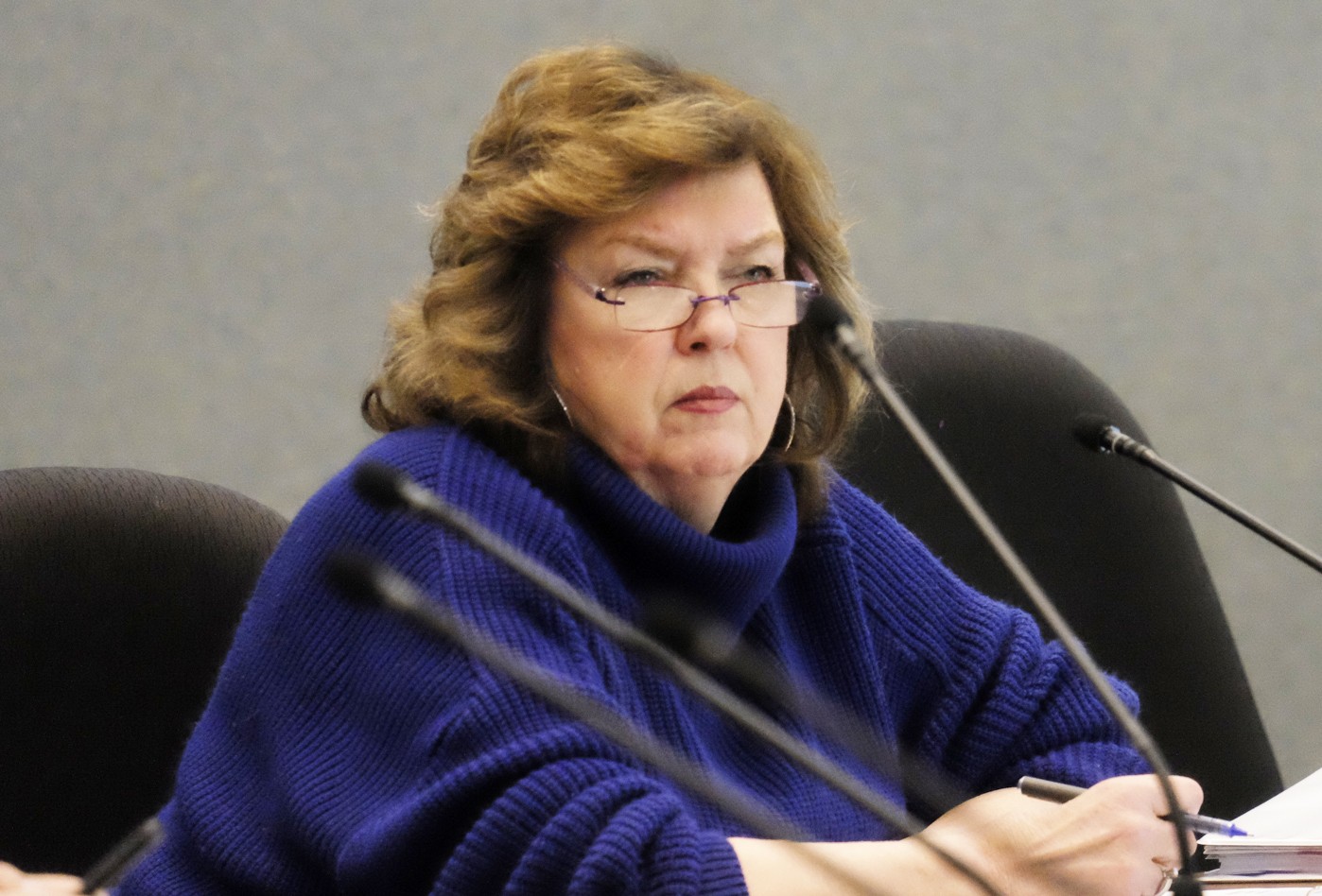
Councillor Carolyn Parrish
During the budget meeting Thursday, Mississauga moved a motion calling for the police to reconsider its budget demands. For the city, the move comes in the context of a proposed municipal budget increase of more than 4 percent on Mississauga’s share of the 2020 property tax bill. The motion asked that the Police Services Board “review the 2020 Police budget to try to achieve a reduction in the 2020 tax increase.”
“We’re moving it [the motion] with a great deal of respect,” Parrish told her fellow councillors. “There’s no attempt to look at any particular part of the budget and say that we don’t approve of it, it’s simply asking them to take another look at it. It’s partially because we’re having a tough budget year, but it’s also because they were asked to reduce it and they didn’t. We’d like them to have the opportunity to take another look at that.”
Despite choosing her words carefully, Parrish met with significant vocal opposition from Brampton Councillor Michael Palleschi and Mayor Brown.
Responding to the motion, Brown said that it was a particularly “challenging environment for public safety in Peel Region” with cuts from the province, also making reference to a rise in gang violence and domestic assaults. “Think about that for a second,” he told his peers, stating the force has to prioritize as it does not “have enough officers to respond to calls,” he claimed.
Both Brown and Crombie sit on the police board and can directly impact the budget through decisions they make regarding the priorities for the force. The board, before Brown’s arrival, has been heavily criticized for approving runaway salary and benefit increases for existing police staff, which have eaten up the lion’s share of the 69 percent police budget increase over the past ten years (including the proposed 5.4 percent increase for 2020).
Policing experts have told The Pointer that throwing money at salaries prevents the hiring of key personnel and the acquisition of critical technology being used by forces across North America to fight complex modern-day crime.
The opposing priorities of Mississauga and Brampton at the region became clear through the budget discussions, with the police at the heart of the problem. Brampton is keen to maintain the police budget and consider cuts elsewhere, while Mississauga showed a willingness to reduce police funding, though Parrish made an impassioned defence of money needed for a community hub the region is contributing to in Malton, which she represents.
Brampton has yet to see its budget document, while Mississauga is pushing for cuts at the region to reduce its tax impact. As a larger and more developed city than Brampton, Mississauga is turning its attention to broader issues and keen to see the police modernize and rely on fewer officers. At the other end of the spectrum, Brown favours tax freezes, but views the police as a relatively untouchable element of the budget process. It’s unclear why he refuses to apply to the police the same standard for fiscal belt tightening and rigorous examination of departmental budgets he has repeatedly hammered on when talking about other areas of government. Brown has correlated more police funding with better responsiveness to crime, while experts and other council members have said the police department needs to look at better models for things such as deployment, investment in technology instead of salaries, intelligence capabilities and the hiring of expert civilian staff instead of expensive uniform officers.
Despite Brown’s best efforts, the committee voted to send the budget back to the Police Services Board for further review. The whole Brampton contingent as well as Caledon councillor Johanna Downey voted against sending the budget back, while all other councillors voted for the motion with only Caledon Mayor Allan Thompson abstaining.
Under the Police Services Act, the board has no requirement to change the budget and can choose to return it to the budget committee in its current form. Should it do that, councillors would have to decide whether to approve it without changes or have it referred to the province to adjudicate.
“We had 12,000 domestic violence calls last year, we’ve got real problems with guns and gangs, the notion that people around the table are contemplating taking police officers off the street makes me livid,” Brown told The Pointer after the vote. “It’s our job to protect the public safety of the region and the fact that some people think… we can actually cut back on our ability to respond is infuriating.”
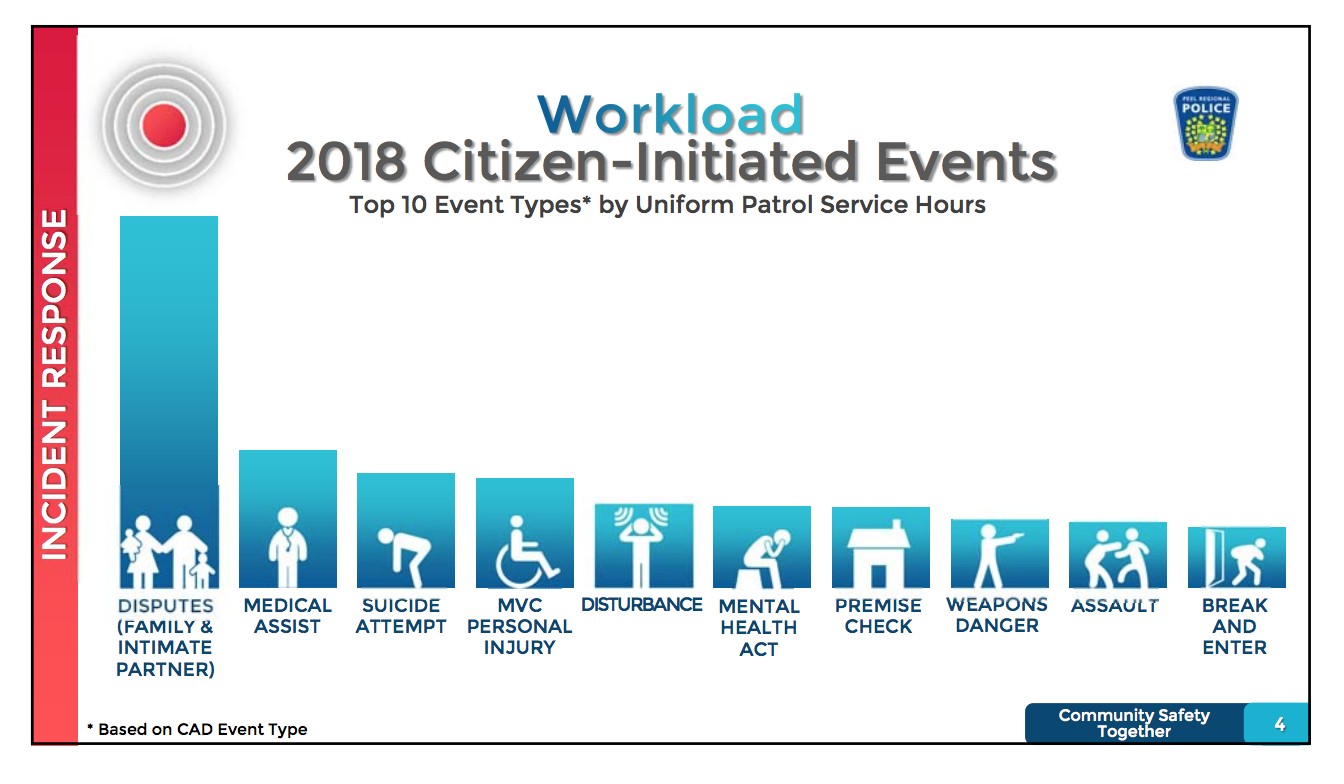
“There’s no changes that can be made,” he added. “The only thing that can be suggested would be to let go of officers.” Brown seems to be engaging in political tactics, as his comments are not founded; no officers would be let go due to a reduction in the requested budget increase. However, any such reduction could prevent the hiring of some of the additional 35 officers the proposed budget calls for. The force has already reduced that figure by 20 officers, after originally calling for 55 new frontline staff in its first 2020 budget proposal. But the change shifted the hiring focus, as the reduction of 20 uniform staff came with a proposed increase of 18 civilian staff.
Mississauga Mayor Bonnie Crombie, who sits on the Police Services Board alongside Brown, took a different view. “When we first did the police budget we did vote in support of it,” she said, speaking to the media after the sudden adjournment of council Thursday. “I think we’re looking at it through a different lens today, through a different perspective given some of the provincial grants we applied for didn’t come through… So we’re looking for efficiencies everywhere. I think it’s worthwhile to go back and take a sober second look, another second look, at the police budget as well.”
Councillor Parrish, who tabled the successful motion to return the police budget to its board, told The Pointer she thought the new Chief, Nishan Duraiappah, could find savings, referencing her “high opinion” of him and his care for the community.
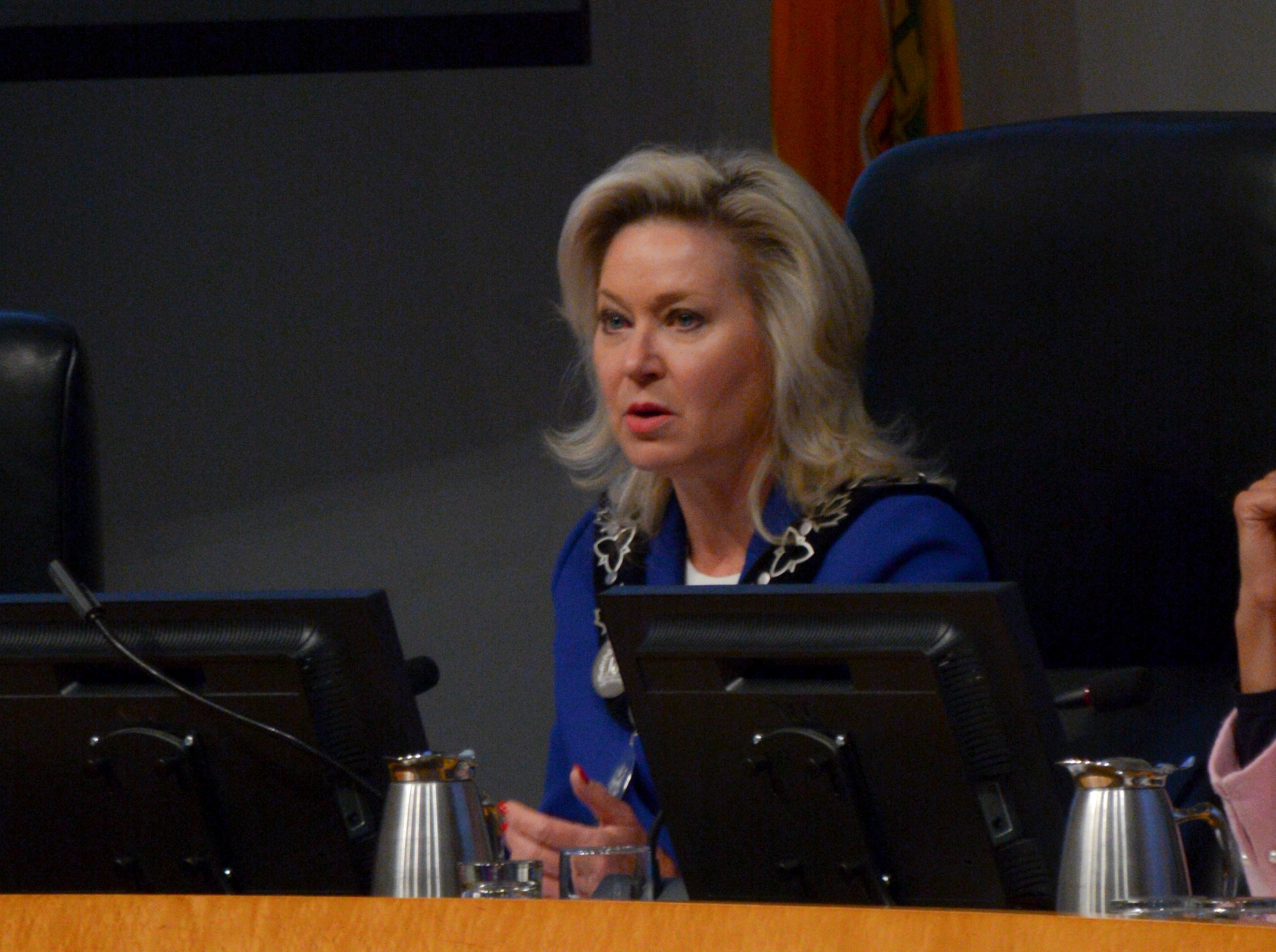
Mayor Bonnie Crombie
“Council's choosing areas of concern and suggested places to cut is actually against the Police Act,” she said. “I am happy to have the Chief and the Police Services Board review their budget request and hopefully they will come back with a reduction that they can live with and Council will approve… . The two mayors are on the Police Services Board and were divided. The budget impact of the Police Budget is greater on Mississauga than it is on Brampton, so that may explain the division somewhat. The bigger issue is 19.1 [a motion on the regional agenda] which allocates $69 million more to Mississauga than our fair share of Police Services. The first vote may have been a bit of a warm up.”
And indeed it was.
After the budget meeting was adjourned for further deliberation next week, the normal regional council meeting began.
With a fairly disorganized agenda, councillors discussed safe injection sites, school buses and heritage homes, before Parrish brought another police motion, this time to council and not budget committee.
Leaning on Jeff Jackson, Director Finance and Treasurer for the City of Mississauga, to explain the police formula calculations and the disparity which Mississauga feels it creates, the motion suggested a new funding formula for Peel Regional Police.
The motion called for a funding formula based, in part, on actual police usage. Similar to the funding model operated by the OPP to charge Caledon (which is not patrolled by Peel police), the suggestion would see funding for the police based on assessment and the number of calls in each city. This figure could be adjusted based on the complexity and nature of calls received by police in each city. Calculations by Mississauga city staff using the region’s Ernst and Young report commissioned to provide financial-cost breakdowns for the province’s regional review, suggest an OPP-style funding formula could save the country’s sixth largest city as much as $69 million per year, but that amount would shift to Brampton under such a cost structure. This was disputed by Mayor Brown in a budget meeting last week.
Parrish’s motion asks for a more usage-based model, with cities paying for the level of policing they use. Though Brampton members strongly dispute the numbers, city staff in Mississauga are confident their residents are paying more than their fair share.
The discussion barely got going on the funding formula and the motion, before a vote was called. Of the Brampton contingent, only Councillor Martin Medeiros was able to speak to the motion, calling it “premature” and telling council he was “disappointed” the motion had been brought forward in a rushed manner without giving Brampton proper opportunity to assess the suggested police funding model.
When the question was called for a vote, with Brown already absent having just left the building, Brampton’s full complement of councillors rose from their seats and exited. Confusion ensued, with the regional clerk establishing that council must wait 30 minutes without quorum before adjourning the meeting.
During the wait, Mississauga and Caledon councillors ate at their desks, while Brampton’s councillors convened a hurried meeting in the building’s cafeteria. At the end of the time, council was adjourned without a confirmatory bylaw, meaning that the discussions which took place during the council meeting (not the earlier budget committee meeting) would remain in a draft scenario.
“I was a little bit surprised,” Mayor Crombie told the media. “I think Brampton realized this was on the agenda, they’ve had the agenda for over a week now. So it was no surprise that it was being brought forward, [especially] given that we also had a staff member here presenting on the issue. We’ve discussed it previously at our council as well. The reaction was unfair.”
“We’re only asking for equity,” she added. “There is precedent, we had the assessment change through waste management back in 2010, so if you can do it for waste, you can certainly do it for police.”
After the meeting, a spokesperson for the mayor provided additional details. “Mississauga pays 63.1% of the policing costs with Brampton contributing 36.9%,” the spokesperson said. “This is fundamentally unfair. Mississauga taxpayers are currently overpaying for Peel Regional Police services by up to $69 million annually. That's based on the independent analysis by Ernst & Young, based on the same principles that are used by the province to charge Caledon for policing services from the OPP. This represents a vast majority of the roughly $84 million more a year that Mississauga sends to the Region than we are receiving back in services.”
None of these points are necessarily new, with Mississauga touting these figures throughout the budget process. Councillors, especially Parrish, have made them a headline issue since the Regional Review did not result in independence for Mississauga.
Speaking to The Pointer, Brown took a radically different view.
“Their numbers are flawed,” he said. “They’re complaining about the share they pay for the police budget – this is based on property tax assessment. This is set by the province. They have a complaint about their property tax assessment rates? Take it up with the province.”
Offering additional comments after the walkout took place, Brown said the argument Mississauga was making around the OPP model was “flawed” and “doesn’t hold water”, adding that he and Brampton were not open to reapportioning police costs in any way at all. “I hope Mississauga realizes that they have no support for this move and accept it,” he said, calling on regional government to continue with more pressing matters.
Though extremely rare, this is not the first time this has happened at the Region of Peel. Speaking to the media, the regional clerk, Kathryn Lockyer, said she recalled it happening at least twice since 2000.
However, the process in place means that Brampton cannot simply walk away. Instead, when council meets again (which could be as soon as next week, with a special council meeting in the works), they will pick up where they left off. In this case, that means the Region of Peel council will likely begin their next session with a vote on Parrish’s controversial motion for the $69 million funding shift.
Some might argue this was never about policing, though. Mississauga went into the vote with the knowledge that Brampton wouldn’t support its ask, but they did it anyway.
Mississauga might be just getting started, as some of its members vowed after failing to gain independence that they would make life difficult until they get what they ultimately want.
Email: [email protected]
Twitter: @isaaccallan
Tel: 647-561-4879
Submit a correction about this story


